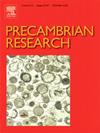Petrogenesis and tectonic implications of the Neoproterozoic A-type granite in the Quanji Massif, northeastern of the Tibetan Plateau
IF 3.2
2区 地球科学
Q2 GEOSCIENCES, MULTIDISCIPLINARY
引用次数: 0
Abstract
A-type granites have unique geochemical characteristics, indicating an extensional tectonic environment, thus providing critical constraints on magma sources and tectonic mechanisms, and playing a crucial role in reconstructing orogenic events. In this contribution, we conducted a systematic study on zircon U-Pb geochronology, whole-rock geochemistry, and zircon Hf isotope of the new identified A-type granites in the Quanji Massif in the northeastern Tibetan Plateau to discuss its petrogenesis and the tectonic implications. The zircon U-Pb dating results show that the crystallization ages of granites and granite porphyries are 797 ± 8 Ma and 799 ± 7 Ma, respectively, indicating that they were formed in the Neoproterozoic. Geochemically, these rocks have high SiO2 (67.47–75.74 wt%) and total alkali (Na2O + K2O = 6.89–8.84 wt%) contents, low MgO (0.11–1.37 wt%), CaO (0.76–1.29 wt%), and P2O5 (0.05–0.18 wt%) contents, with negative anomalies of Nb, Ta, Ti, Sr, and Eu elements. They have high FeOT /(MgO + FeOT) values, Zr + Nb + Ce + Y contents (343–562 ppm), 10000 × Ga/Al ratio (2.12–3.20), and zircon saturation temperature (804–860 ℃), which are consistent with the characteristics of typical A-type granites. Their high K2O/Na2O ratios, low Sr/Y and La/Yb ratios, combined with the zircon εHf(t) values (–4.04 to 3.25) and the whole-rock εNd(t) values (–8.28 to –4.91), indicate that the A-type granites were derived from partial melting of the calc-alkaline rocks in the ancient crust with a moderate contribution of juvenile crust under high temperature and low-pressure conditions. Based on the tectonic setting discrimination diagram combined with regional data, it is comprehensively determined that the A-type granites were formed in the post-collisional extensional environment, which is a response to the breakup of the Rodinia supercontinent. According to the comprehensive data of the Quanji Massif and adjacent areas show that the Quanji Massif, the Qaidam Block and the Qilian Block were combined into a unified block during the Late Mesoproterozoic-Neoproterozoic and participated in the evolution of the Rodinia supercontinent.
求助全文
约1分钟内获得全文
求助全文
来源期刊

Precambrian Research
地学-地球科学综合
CiteScore
7.20
自引率
28.90%
发文量
325
审稿时长
12 months
期刊介绍:
Precambrian Research publishes studies on all aspects of the early stages of the composition, structure and evolution of the Earth and its planetary neighbours. With a focus on process-oriented and comparative studies, it covers, but is not restricted to, subjects such as:
(1) Chemical, biological, biochemical and cosmochemical evolution; the origin of life; the evolution of the oceans and atmosphere; the early fossil record; palaeobiology;
(2) Geochronology and isotope and elemental geochemistry;
(3) Precambrian mineral deposits;
(4) Geophysical aspects of the early Earth and Precambrian terrains;
(5) Nature, formation and evolution of the Precambrian lithosphere and mantle including magmatic, depositional, metamorphic and tectonic processes.
In addition, the editors particularly welcome integrated process-oriented studies that involve a combination of the above fields and comparative studies that demonstrate the effect of Precambrian evolution on Phanerozoic earth system processes.
Regional and localised studies of Precambrian phenomena are considered appropriate only when the detail and quality allow illustration of a wider process, or when significant gaps in basic knowledge of a particular area can be filled.
 求助内容:
求助内容: 应助结果提醒方式:
应助结果提醒方式:


